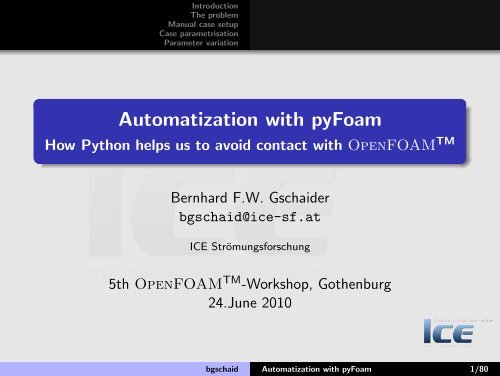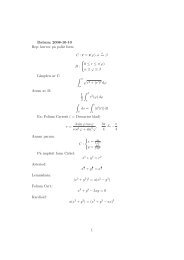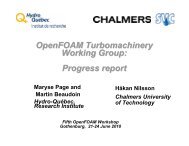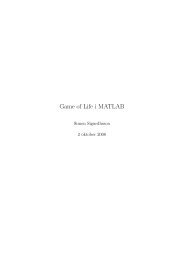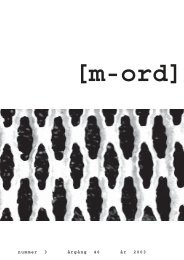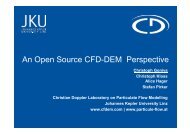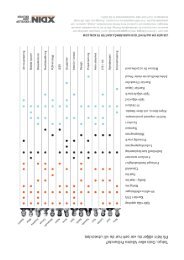Automatization with pyFoam - How Python helps us to avoid contact ...
Automatization with pyFoam - How Python helps us to avoid contact ...
Automatization with pyFoam - How Python helps us to avoid contact ...
- No tags were found...
Create successful ePaper yourself
Turn your PDF publications into a flip-book with our unique Google optimized e-Paper software.
Introduction<br />
The problem<br />
Manual case setup<br />
Case parametrisation<br />
Parameter variation<br />
<strong>Au<strong>to</strong>matization</strong> <strong>with</strong> <strong>pyFoam</strong><br />
<strong>How</strong> <strong>Python</strong> <strong>helps</strong> <strong>us</strong> <strong>to</strong> <strong>avoid</strong> <strong>contact</strong> <strong>with</strong> OpenFOAM TM<br />
Bernhard F.W. Gschaider<br />
bgschaid@ice-sf.at<br />
ICE Strömungsforschung<br />
5th OpenFOAM TM -Workshop, Gothenburg<br />
24.June 2010<br />
bgschaid <strong>Au<strong>to</strong>matization</strong> <strong>with</strong> <strong>pyFoam</strong> 1/80
Overview<br />
Introduction<br />
The problem<br />
Manual case setup<br />
Case parametrisation<br />
Parameter variation<br />
1 Introduction<br />
Overview<br />
PyFoam<br />
Technicalities<br />
<strong>Python</strong> - a crash course<br />
2 The problem<br />
What we’re simulating<br />
The solver<br />
Getting our hands dirty<br />
3 Manual case setup<br />
Preparing the case<br />
Running the simulation<br />
c<strong>us</strong><strong>to</strong>mRegexp<br />
Post processing<br />
4 Case parametrisation<br />
Dictionaries<br />
Templates<br />
An old-school script<br />
A python script<br />
5 Parameter variation<br />
Looking at one line after another<br />
Simple scripts <strong>us</strong>ing it<br />
Script <strong>with</strong> variations<br />
Using it and results<br />
bgschaid <strong>Au<strong>to</strong>matization</strong> <strong>with</strong> <strong>pyFoam</strong> 2/80
Introduction<br />
The problem<br />
Manual case setup<br />
Case parametrisation<br />
Parameter variation<br />
Aim of this presentation<br />
Overview<br />
PyFoam<br />
Technicalities<br />
<strong>Python</strong> - a crash course<br />
This presentation shows how <strong>to</strong> <strong>us</strong>e PyFoam <strong>to</strong> run a case<br />
au<strong>to</strong>matically and evaluate the results<br />
It does not give<br />
• a full overview of <strong>Python</strong><br />
• an overview of all the capabilities of PyFoam<br />
It assumes<br />
• that you know your way around OpenFOAM TM<br />
• have programmed a little bit in some language (not<br />
necessarily <strong>Python</strong>)<br />
bgschaid <strong>Au<strong>to</strong>matization</strong> <strong>with</strong> <strong>pyFoam</strong> 3/80
What is PyFoam<br />
Introduction<br />
The problem<br />
Manual case setup<br />
Case parametrisation<br />
Parameter variation<br />
Overview<br />
PyFoam<br />
Technicalities<br />
<strong>Python</strong> - a crash course<br />
PyFoam is<br />
1 a <strong>Python</strong> library that<br />
• manipulates OpenFOAM TM -cases<br />
• controls OpenFOAM TM -runs<br />
2 Utilities based on that library<br />
bgschaid <strong>Au<strong>to</strong>matization</strong> <strong>with</strong> <strong>pyFoam</strong> 4/80
Introduction<br />
The problem<br />
Manual case setup<br />
Case parametrisation<br />
Parameter variation<br />
What happened before<br />
Overview<br />
PyFoam<br />
Technicalities<br />
<strong>Python</strong> - a crash course<br />
• Last year in Montreal a presentation PyFoam - Happy<br />
foaming <strong>with</strong> <strong>Python</strong> (URL below) was given<br />
• It is not necessary that you have read it<br />
• .... but helpful (Now it’s <strong>to</strong> late. Read it later.)<br />
• We were introduced <strong>to</strong> the CFD-engineer Ignaz<br />
Gartengschirrl<br />
• A specialist on calculating the damBreak-case<br />
• ... <strong>us</strong>ing PyFoam<br />
• During the last year Ignaz extended<br />
• his professional range<br />
• his knowledge of PyFoam<br />
http://www.openfoamworkshop.org/2009/4th_Workshop/0_Feature_Presentations/OFW4_2009_Gschaider_PyFoam.pdf<br />
bgschaid <strong>Au<strong>to</strong>matization</strong> <strong>with</strong> <strong>pyFoam</strong> 5/80
Conventions<br />
Introduction<br />
The problem<br />
Manual case setup<br />
Case parametrisation<br />
Parameter variation<br />
Overview<br />
PyFoam<br />
Technicalities<br />
<strong>Python</strong> - a crash course<br />
Whenever Ignaz (and also you)<br />
writes something<br />
• on the shell<br />
• in an edi<strong>to</strong>r<br />
it will be found in a coloured box.<br />
Sometimes there will be output,<br />
<strong>to</strong>o<br />
Ignaz writes on the shell<br />
1 > date<br />
Fri May 15 01:56:12 CEST 2009<br />
Ignaz’s <strong>Python</strong>-code<br />
sum =0<br />
2 for v in [7 ,13 ,42]:<br />
sum +=v<br />
4 print " The ␣ sum ␣is",sum<br />
# this is a long line that will be <br />
continued in the next line<br />
Ignaz edits a file<br />
1 fooCoeffs {<br />
bar 23;<br />
3 lst ( inlet outlet );<br />
}<br />
bgschaid <strong>Au<strong>to</strong>matization</strong> <strong>with</strong> <strong>pyFoam</strong> 6/80
Introduction<br />
The problem<br />
Manual case setup<br />
Case parametrisation<br />
Parameter variation<br />
Overview<br />
PyFoam<br />
Technicalities<br />
<strong>Python</strong> - a crash course<br />
Getting the git-archive <strong>with</strong> the data<br />
• The data and programs needed are in a tar-file on the stick<br />
• If you haven’t booted from the stick the paths may be different<br />
for you<br />
• First we copy it <strong>to</strong> your home and create a working direc<strong>to</strong>ry:<br />
Preparing for work<br />
> cd $HOME<br />
2 > mkdir <strong>pyFoam</strong>Advanced<br />
> cd <strong>pyFoam</strong>Advanced<br />
4 > tar xzf / cdrom / OFW5 / Advanced_Training / <strong>pyFoam</strong>Advanced . git . tgz<br />
• Now there should be a direc<strong>to</strong>ry <strong>pyFoam</strong>Advanced.git<br />
bgschaid <strong>Au<strong>to</strong>matization</strong> <strong>with</strong> <strong>pyFoam</strong> 7/80
Introduction<br />
The problem<br />
Manual case setup<br />
Case parametrisation<br />
Parameter variation<br />
Getting <strong>to</strong> a specific step<br />
Overview<br />
PyFoam<br />
Technicalities<br />
<strong>Python</strong> - a crash course<br />
• What we extracted is a Git-archive<br />
• There are several branches for different phases<br />
• So if you couldn’t follow you can catch up<br />
Going <strong>to</strong> a specific step<br />
> cd $HOME / <strong>pyFoam</strong>Advanced<br />
2 > git clone <strong>pyFoam</strong>Advanced . git -b step1manualStarting step1<br />
• Now there should be a direc<strong>to</strong>ry step1<br />
bgschaid <strong>Au<strong>to</strong>matization</strong> <strong>with</strong> <strong>pyFoam</strong> 8/80
What is <strong>Python</strong><br />
Introduction<br />
The problem<br />
Manual case setup<br />
Case parametrisation<br />
Parameter variation<br />
Overview<br />
PyFoam<br />
Technicalities<br />
<strong>Python</strong> - a crash course<br />
<strong>Python</strong><br />
• Is a scripting language<br />
• No compilation required<br />
• Is object-oriented<br />
• Comes batteries included: has a large standard-library for<br />
many common tasks<br />
• Non essential parts (like regular expressions) were moved <strong>to</strong><br />
the library<br />
• Widely <strong>us</strong>ed<br />
• Pre-installed on most Linux-systems beca<strong>us</strong>e many system<br />
<strong>to</strong>ols (installers for instance) <strong>us</strong>e it<br />
• Becomes scripting language of choice for a number of<br />
programs (amongst others the post-processors ParaView<br />
and Visit and the pre-processor Salome)<br />
bgschaid <strong>Au<strong>to</strong>matization</strong> <strong>with</strong> <strong>pyFoam</strong> 9/80
Introduction<br />
The problem<br />
Manual case setup<br />
Case parametrisation<br />
Parameter variation<br />
Overview<br />
PyFoam<br />
Technicalities<br />
<strong>Python</strong> - a crash course<br />
3 things you have <strong>to</strong> know about <strong>Python</strong><br />
... <strong>to</strong> understand the programming examples<br />
1 Indentation does the same thing { and } do for C ++<br />
2 [] signifies a list (which is an array)<br />
3 {} is a dictionary (whose elements are accessed <strong>with</strong> [key])<br />
4 self is the same as this in C ++ (The object itself)<br />
Aeh. The 4 things <strong>to</strong> know about <strong>Python</strong> are ....<br />
bgschaid <strong>Au<strong>to</strong>matization</strong> <strong>with</strong> <strong>pyFoam</strong> 10/80
The <strong>Python</strong> Shell<br />
Introduction<br />
The problem<br />
Manual case setup<br />
Case parametrisation<br />
Parameter variation<br />
Overview<br />
PyFoam<br />
Technicalities<br />
<strong>Python</strong> - a crash course<br />
• <strong>Python</strong>-files <strong>us</strong>ually end <strong>with</strong> the extension .py<br />
Running a <strong>Python</strong>-file<br />
> python test .py<br />
• But you can also <strong>us</strong>e it interactively<br />
Using the <strong>Python</strong>-shell<br />
1 > python<br />
<strong>Python</strong> 2.6.5 ( r265 :79063 , May 18 2010 , 10:54:45)<br />
3 [ GCC 4.2.1 ( Apple Inc . build 5659) ] on darwin<br />
Type " help ", " copyright ", " credits " or " license " for more information .<br />
5 >>> 1+1<br />
2<br />
7 >>> import sys<br />
>>> print sys . platform<br />
9 darwin<br />
>>><br />
exit <strong>with</strong> Ctrl+D<br />
bgschaid <strong>Au<strong>to</strong>matization</strong> <strong>with</strong> <strong>pyFoam</strong> 11/80
Introduction<br />
The problem<br />
Manual case setup<br />
Case parametrisation<br />
Parameter variation<br />
Overview<br />
PyFoam<br />
Technicalities<br />
<strong>Python</strong> - a crash course<br />
Basic constructs - lists and dictionaries<br />
Basic <strong>us</strong>age of lists and dictionaries<br />
>>> lst =[2 ," interFoam " ,1.3]<br />
2 >>> lst [0]<br />
2<br />
4 >>> lst +=[ " nothing "]<br />
>>> print lst<br />
6 [2 , ’ interFoam ’, 1.3 , ’ nothing ’]<br />
>>> order ={ ’ interFoam ’:1 , ’ blockMesh ’:0 , ’ paraFoam ’:2}<br />
8 >>> order [’interFoam ’]<br />
1<br />
10 >>> ’ paraFoam ’ in order<br />
True<br />
12 >>> order [’setFields ’]=0.5<br />
>>> print order<br />
14 {’blockMesh ’: 0, ’ interFoam ’: 1, ’ setFields ’: 0.5 , ’ paraFoam ’: 2}<br />
bgschaid <strong>Au<strong>to</strong>matization</strong> <strong>with</strong> <strong>pyFoam</strong> 12/80
Introduction<br />
The problem<br />
Manual case setup<br />
Case parametrisation<br />
Parameter variation<br />
Basic constructs - loops<br />
Overview<br />
PyFoam<br />
Technicalities<br />
<strong>Python</strong> - a crash course<br />
Two kinds of loops<br />
>>> vals =[2 ,3 ,5 ,7 ,11 ,13 ,17 ,19]<br />
2 >>> for v in vals :<br />
... print v*v,<br />
4 ...<br />
4 9 25 49 121 169 289 361<br />
6 >>> i=0<br />
>>> while i>> print vals<br />
12 [’no ’, 3, ’no ’, 7, ’no ’, 13 , ’no ’, 19]<br />
bgschaid <strong>Au<strong>to</strong>matization</strong> <strong>with</strong> <strong>pyFoam</strong> 13/80
Introduction<br />
The problem<br />
Manual case setup<br />
Case parametrisation<br />
Parameter variation<br />
Basic constructs - branches<br />
Overview<br />
PyFoam<br />
Technicalities<br />
<strong>Python</strong> - a crash course<br />
One kind of branch is sufficient<br />
>>> for i in range ( -3 ,3):<br />
2 ... if i ==0:<br />
... print " zero ",<br />
4 ... elif (i %2) ==0:<br />
... print " even ",<br />
6 ... else :<br />
... print " odd ",<br />
8 ...<br />
odd even odd zero odd even<br />
bgschaid <strong>Au<strong>to</strong>matization</strong> <strong>with</strong> <strong>pyFoam</strong> 14/80
Introduction<br />
The problem<br />
Manual case setup<br />
Case parametrisation<br />
Parameter variation<br />
Basic constructs - classes<br />
Overview<br />
PyFoam<br />
Technicalities<br />
<strong>Python</strong> - a crash course<br />
Ignaz tells <strong>us</strong> all he knows<br />
1 >>> class Ignaz :<br />
... def __init__ (self , val ):<br />
3 ... self . val = val<br />
... def __str__ ( self ):<br />
5 ... return " Ignaz ␣ says ␣"+ str ( self . val )<br />
... def forget ( self ):<br />
7 ... self . val = None<br />
...<br />
9 >>> ig= Ignaz (1+1)<br />
>>> print ig<br />
11 Ignaz says 2<br />
>>> ig. forget ()<br />
13 >>> print ig<br />
Ignaz says None<br />
bgschaid <strong>Au<strong>to</strong>matization</strong> <strong>with</strong> <strong>pyFoam</strong> 15/80
Introduction<br />
The problem<br />
Manual case setup<br />
Case parametrisation<br />
Parameter variation<br />
Overview<br />
PyFoam<br />
Technicalities<br />
<strong>Python</strong> - a crash course<br />
Basic constructs - importing libraries<br />
Standing on the shoulders of ... other programmers<br />
>>> from time import time<br />
2 >>> time ()<br />
1275658314.7988529<br />
4 >>> import sys<br />
>>> dir ( sys )<br />
6 [’__displayhook__ ’, ’ __doc__ ’, ’ __egginsert ’, ’ __excepthook__ ’, ’ __name__ ’, ’<br />
__package__ ’, ’ __plen ’, ’ __stderr__ ’, ’ __stdin__ ’, ’ __stdout__ ’, ’<br />
_clear_type_cache ’, ’ _current_frames ’, ’ _getframe ’, ’ api_version ’, ’<br />
argv ’, ’ builtin_module_names ’, ’ byteorder ’, ’ call_tracing ’, ’<br />
callstats ’, ’ copyright ’, ’ displayhook ’, ’ dont_write_bytecode ’, ’<br />
exc_clear ’, ’ exc_info ’, ’ exc_type ’, ’ excepthook ’, ’ exec_prefix ’, ’<br />
executable ’, ’exit ’, ’flags ’, ’ float_info ’, ’ getcheckinterval ’, ’<br />
getdefaultencoding ’, ’ getdlopenflags ’, ’ getfilesystemencoding ’, ’<br />
getprofile ’, ’ getrecursionlimit ’, ’ getrefcount ’, ’ getsizeof ’, ’<br />
gettrace ’, ’ hexversion ’, ’ last_type ’, ’ last_value ’, ’ maxint ’, ’<br />
maxsize ’, ’ maxunicode ’, ’ meta_path ’, ’ modules ’, ’path ’, ’ path_hooks ’,<br />
’ path_importer_cache ’, ’ platform ’, ’ prefix ’, ’ps1 ’, ’ps2 ’, ’<br />
py3kwarning ’, ’ setappdefaultencoding ’, ’ setcheckinterval ’, ’<br />
setdlopenflags ’, ’ setprofile ’, ’ setrecursionlimit ’, ’ settrace ’, ’<br />
stderr ’, ’stdin ’, ’ stdout ’, ’ subversion ’, ’ version ’, ’ version_info ’, <br />
’ warnoptions ’]<br />
>>> print sys . version<br />
8 2.6.5 ( r265 :79063 , May 18 2010 , 10:54:45)<br />
[ GCC 4.2.1 ( Apple Inc . build 5659) ]<br />
bgschaid <strong>Au<strong>to</strong>matization</strong> <strong>with</strong> <strong>pyFoam</strong> 16/80
Introduction<br />
The problem<br />
Manual case setup<br />
Case parametrisation<br />
Parameter variation<br />
<strong>How</strong> <strong>to</strong> get help - On the shell<br />
Overview<br />
PyFoam<br />
Technicalities<br />
<strong>Python</strong> - a crash course<br />
What is that ParsedParameterFile anyway<br />
1 >>> from PyFoam . RunDictionary . ParsedParameterFile import <br />
ParsedParameterFile<br />
>>> print ParsedParameterFile . getCaseDir . __doc__<br />
3 Return the path <strong>to</strong> the case of this file (if any valid case is found ).<br />
Else return None<br />
5 >>> help ( ParsedParameterFile<br />
Help on class ParsedParameterFile in module PyFoam . RunDictionary .<br />
ParsedParameterFile :<br />
7<br />
class ParsedParameterFile ( PyFoam . RunDictionary . FileBasis . FileBasisBackup )<br />
9 | Parameterfile whose complete representation is read in<strong>to</strong><br />
| memory , can be manipulated and afterwards written <strong>to</strong> disk<br />
11 |<br />
| Method resolution order :<br />
13 ...<br />
• All these texts were extracted from the source:<br />
• <strong>Python</strong> comes <strong>with</strong> an included Doxygen<br />
bgschaid <strong>Au<strong>to</strong>matization</strong> <strong>with</strong> <strong>pyFoam</strong> 17/80
Help on PyFoam<br />
Introduction<br />
The problem<br />
Manual case setup<br />
Case parametrisation<br />
Parameter variation<br />
Overview<br />
PyFoam<br />
Technicalities<br />
<strong>Python</strong> - a crash course<br />
• With the help of a program called epydoc a more <strong>us</strong>er<br />
friendly Html-documentation can be produced<br />
• This documentation is included in the normal distribution<br />
bgschaid <strong>Au<strong>to</strong>matization</strong> <strong>with</strong> <strong>pyFoam</strong> 18/80
Introduction<br />
The problem<br />
Manual case setup<br />
Case parametrisation<br />
Parameter variation<br />
What we’re simulating<br />
The solver<br />
Getting our hands dirty<br />
Separating particles of different size<br />
• Ignaz is asked <strong>to</strong> design a particle separa<strong>to</strong>r<br />
• He knows the physics: Drag-force vs. gravity<br />
bgschaid <strong>Au<strong>to</strong>matization</strong> <strong>with</strong> <strong>pyFoam</strong> 19/80
Introduction<br />
The problem<br />
Manual case setup<br />
Case parametrisation<br />
Parameter variation<br />
What we’re simulating<br />
The solver<br />
Getting our hands dirty<br />
The simplified particle separa<strong>to</strong>r<br />
• After 2 weeks the CAD-engineer came up <strong>with</strong> this complex<br />
design<br />
• Inlet and particle injec<strong>to</strong>r at the left<br />
bgschaid <strong>Au<strong>to</strong>matization</strong> <strong>with</strong> <strong>pyFoam</strong> 20/80
Introduction<br />
The problem<br />
Manual case setup<br />
Case parametrisation<br />
Parameter variation<br />
What a solution looks like<br />
What we’re simulating<br />
The solver<br />
Getting our hands dirty<br />
• The goal is: Change the inlet velocity of the channel in such a<br />
way that<br />
• The number of particles in the second bin maximizes<br />
• No (or as few as possible) particles leave through the oultet<br />
bgschaid <strong>Au<strong>to</strong>matization</strong> <strong>with</strong> <strong>pyFoam</strong> 21/80
Introduction<br />
The problem<br />
Manual case setup<br />
Case parametrisation<br />
Parameter variation<br />
Basis: rhoPisoTwinParcelFoam<br />
What we’re simulating<br />
The solver<br />
Getting our hands dirty<br />
• Our solver is based on rhoPisoTwinParcelFoam which can<br />
be found in the tu<strong>to</strong>rials. It is<br />
• transient<br />
• compressible<br />
• turbulent<br />
• has two different populations of particles<br />
• Changes in rhoPisoAbscheidParcelFoam are<br />
• Only one particle population<br />
• New particle class<br />
bgschaid <strong>Au<strong>to</strong>matization</strong> <strong>with</strong> <strong>pyFoam</strong> 22/80
Introduction<br />
The problem<br />
Manual case setup<br />
Case parametrisation<br />
Parameter variation<br />
Where do the particles go<br />
What we’re simulating<br />
The solver<br />
Getting our hands dirty<br />
• The whole solver had <strong>to</strong> be written for this method:<br />
In basicAbscheideParcel.C<br />
1 void Foam :: basicAbscheideParcel :: hitPatch<br />
(<br />
3 const polyPatch & p, trackData & td<br />
)<br />
5 {<br />
Pout
Building the solver<br />
Introduction<br />
The problem<br />
Manual case setup<br />
Case parametrisation<br />
Parameter variation<br />
What we’re simulating<br />
The solver<br />
Getting our hands dirty<br />
1 Get the first stage (if we haven’t already done so)<br />
Getting it <strong>with</strong> Git<br />
1 > cd $HOME / <strong>pyFoam</strong>Advanced<br />
> git clone <strong>pyFoam</strong>Advanced . git -b step1manualStarting step1<br />
3 > cd step1<br />
2 Compiling the solver (we only have <strong>to</strong> do this once)<br />
Making sure we <strong>us</strong>e the right OpenFOAM TM -version<br />
1 > <strong>pyFoam</strong>Execute .py -- foam =1.5 - dev wmake solver / rhoPisoAbscheidParcelFoam15<br />
PyFoam WARNING on line 152 of file / software / PyFoam / FoamInformation .py : 1.5 - dev is <br />
already being <strong>us</strong>ed<br />
Compiling it for debugging<br />
> <strong>pyFoam</strong>Execute .py -- foam =1.5 - dev --force - debug wmake solver / rhoPisoAbscheidParcelFoam15<br />
bgschaid <strong>Au<strong>to</strong>matization</strong> <strong>with</strong> <strong>pyFoam</strong> 24/80
A clean slate<br />
Introduction<br />
The problem<br />
Manual case setup<br />
Case parametrisation<br />
Parameter variation<br />
Preparing the case<br />
Running the simulation<br />
c<strong>us</strong><strong>to</strong>mRegexp<br />
Post processing<br />
• Ignaz likes <strong>to</strong> start <strong>with</strong> a new case<br />
Making a copy<br />
1 > <strong>pyFoam</strong>CloneCase .py --add = default . pvsm cases / twoCavityChannel <br />
testSepara<strong>to</strong>r<br />
PyFoam WARNING on line 85 of file / Users / bgschaid / private_python / PyFoam /<br />
Applications / CloneCase .py : Direc<strong>to</strong>ry does not exist . Creating<br />
3 > cd testSepara<strong>to</strong>r<br />
• Now he can modify the case any way he likes<br />
bgschaid <strong>Au<strong>to</strong>matization</strong> <strong>with</strong> <strong>pyFoam</strong> 25/80
Introduction<br />
The problem<br />
Manual case setup<br />
Case parametrisation<br />
Parameter variation<br />
Editing the blockMesh<br />
Preparing the case<br />
Running the simulation<br />
c<strong>us</strong><strong>to</strong>mRegexp<br />
Post processing<br />
Making blockMesh less painful<br />
1 > <strong>pyFoam</strong>DisplayBlockMesh .py constant / polyMesh / blockMeshDict<br />
bgschaid <strong>Au<strong>to</strong>matization</strong> <strong>with</strong> <strong>pyFoam</strong> 26/80
Introduction<br />
The problem<br />
Manual case setup<br />
Case parametrisation<br />
Parameter variation<br />
Preparing the case<br />
Running the simulation<br />
c<strong>us</strong><strong>to</strong>mRegexp<br />
Post processing<br />
Checking the boundary conditions<br />
All boundary conditions at once<br />
1 > <strong>pyFoam</strong>CaseReport .py --short -bc .<br />
3 Table of boundary conditions for t = 0<br />
5 | abscheider1 | abscheider2 | bot<strong>to</strong>m | defaultFaces | inlet | outlet | <strong>to</strong>p<br />
--------------------------------------------------------------------------------------------------------------------<br />
Patch Type | patch | patch | wall | empty | patch | patch | wall<br />
7<br />
Length | 10 | 10 | 70 | 1400 | 10 | 10 | 50<br />
--------------------------------------------------------------------------------------------------------------------<br />
9<br />
T | inletOutlet | inletOutlet | zeroGradient | empty | fixedValue | zeroGradient | zeroGradient<br />
U | fixedValue | fixedValue | fixedValue | empty | fixedValue | inletOutlet | fixedValue<br />
11<br />
epsilon | inletOutlet | inletOutlet | zeroGradient | empty | fixedValue | inletOutlet | zeroGradient<br />
13 k | inletOutlet | inletOutlet | zeroGradient | empty | fixedValue | inletOutlet | zeroGradient<br />
p | zeroGradient | zeroGradient | zeroGradient | empty | zeroGradient | fixedValue | zeroGradient<br />
Other things the <strong>to</strong>ol can report<br />
> <strong>pyFoam</strong>CaseReport .py -- help<br />
bgschaid <strong>Au<strong>to</strong>matization</strong> <strong>with</strong> <strong>pyFoam</strong> 27/80
Introduction<br />
The problem<br />
Manual case setup<br />
Case parametrisation<br />
Parameter variation<br />
Preparing for parallel runs<br />
Preparing the case<br />
Running the simulation<br />
c<strong>us</strong><strong>to</strong>mRegexp<br />
Post processing<br />
2 CPUs is all we have<br />
1 > <strong>pyFoam</strong>Decompose .py . 2<br />
...<br />
3 > <strong>pyFoam</strong>CaseReport .py -- decomposition .<br />
Case is decomposed for 2 processors<br />
5 | 0 1<br />
-----------------------------<br />
7 Points | 814 770<br />
Faces | 1486 1404<br />
9 Cells | 360 340<br />
-----------------------------<br />
11 abscheider1 | 10 0<br />
abscheider2 | 0 10<br />
13 bot<strong>to</strong>m | 36 34<br />
defaultFaces | 720 680<br />
15 inlet | 10 0<br />
outlet | 0 10<br />
17 <strong>to</strong>p | 26 24<br />
bgschaid <strong>Au<strong>to</strong>matization</strong> <strong>with</strong> <strong>pyFoam</strong> 28/80
Hey! Ho! Let’s go!<br />
Introduction<br />
The problem<br />
Manual case setup<br />
Case parametrisation<br />
Parameter variation<br />
Preparing the case<br />
Running the simulation<br />
c<strong>us</strong><strong>to</strong>mRegexp<br />
Post processing<br />
At last Ignaz is eager <strong>to</strong> see some numbers ...<br />
Removing old data and starting the run<br />
1 > <strong>pyFoam</strong>Runner .py -- progress -- proc =2 -- clear rhoPisoAbscheidParcelFoam<br />
Reading regular expressions from / Volumes / Rest / StickTest / Shared / AdvanzedWork / step1 /<br />
testSepara<strong>to</strong>r / c<strong>us</strong><strong>to</strong>mRegexp<br />
3 Clearing out old timesteps ....<br />
t = 0.0736599<br />
5<br />
...<br />
7<br />
> less PyFoamRunner . rhoPisoAbscheidParcelFoam . logfile<br />
9 /*---------------------------------------------------------------------------*\<br />
| ========= | |<br />
11 | \\ / F ield | OpenFOAM : The Open Source CFD Toolbox |<br />
| \\ / O peration | Version : 1.5 - dev |<br />
13 | \\ / A nd | Revision : exported |<br />
| \\/ M anipulation | Web : http :// www . OpenFOAM . org |<br />
15 \*---------------------------------------------------------------------------*/<br />
Exec : rhoPisoAbscheidParcelFoam<br />
17 ...<br />
bgschaid <strong>Au<strong>to</strong>matization</strong> <strong>with</strong> <strong>pyFoam</strong> 29/80
Introduction<br />
The problem<br />
Manual case setup<br />
Case parametrisation<br />
Parameter variation<br />
Preparing the case<br />
Running the simulation<br />
c<strong>us</strong><strong>to</strong>mRegexp<br />
Post processing<br />
Regular expressions in 3 minutes<br />
• Regular expressions are essential for c<strong>us</strong><strong>to</strong>mRegexp (therefor<br />
the name)<br />
• Usually a letter is matched by itself<br />
• . matches any letter<br />
• Patterns are enclosed by ( and )<br />
• Patterns are numbered by the order in which they appear in<br />
the expression<br />
• + means “repeat the previo<strong>us</strong> pattern at least once”<br />
• %f% is PyFoam-shorthand for a regular expression that<br />
matches any floating-point number<br />
bgschaid <strong>Au<strong>to</strong>matization</strong> <strong>with</strong> <strong>pyFoam</strong> 30/80
Introduction<br />
The problem<br />
Manual case setup<br />
Case parametrisation<br />
Parameter variation<br />
Parcels in the system<br />
Preparing the case<br />
Running the simulation<br />
c<strong>us</strong><strong>to</strong>mRegexp<br />
Post processing<br />
Ignaz wants a plot of the parcels in<br />
the system<br />
expr The regular<br />
expression that should<br />
be matched<br />
theTitle Title of the plot<br />
name List of annotations<br />
Simple plot<br />
1 parcels<br />
{<br />
3 theTitle " Number ␣of␣ parcels ";<br />
expr<br />
5 titles ( nr );<br />
}<br />
" Current ␣ number ␣of␣<br />
parcels ␣␣␣␣␣␣␣=␣(%f<br />
%)";<br />
bgschaid <strong>Au<strong>to</strong>matization</strong> <strong>with</strong> <strong>pyFoam</strong> 31/80
Introduction<br />
The problem<br />
Manual case setup<br />
Case parametrisation<br />
Parameter variation<br />
Mass leaving the system<br />
Preparing the case<br />
Running the simulation<br />
c<strong>us</strong><strong>to</strong>mRegexp<br />
Post processing<br />
List of exits is not previo<strong>us</strong>ly<br />
known. type dynamic allows <strong>to</strong><br />
dynamically build it<br />
idNr The pattern number<br />
of the ID (name)<br />
accumulation sum means that<br />
several occurences of<br />
a pattern in a<br />
time-step will be<br />
added (<strong>us</strong>ually only<br />
the first is <strong>us</strong>ed)<br />
<strong>with</strong> <strong>How</strong> the data should<br />
be plotted (see <strong>with</strong><br />
in GnuPlot)<br />
Simple plot<br />
amount<br />
2 {<br />
theTitle " Mass ␣ removed ";<br />
4 expr " Abgeschieden ␣at␣ (.+) ␣<br />
<strong>with</strong> ␣.+␣ <strong>to</strong>tal :␣(%f%)<br />
";<br />
type dynamic ;<br />
6 idNr 1;<br />
<strong>with</strong> impulses ;<br />
8 accumulation sum ;<br />
}<br />
bgschaid <strong>Au<strong>to</strong>matization</strong> <strong>with</strong> <strong>pyFoam</strong> 32/80
Using it <strong>to</strong> plot<br />
Introduction<br />
The problem<br />
Manual case setup<br />
Case parametrisation<br />
Parameter variation<br />
Preparing the case<br />
Running the simulation<br />
c<strong>us</strong><strong>to</strong>mRegexp<br />
Post processing<br />
Displaying from a logfile<br />
1 > <strong>pyFoam</strong>PlotWatcher .py PyFoamRunner . rhoPisoAbscheidParcelFoam . logfile<br />
Saving pictures afterwards<br />
1 > <strong>pyFoam</strong>PlotWatcher .py -- progress PyFoamRunner . rhoPisoAbscheidParcelFoam . logfile --<br />
hardcopy<br />
Using matplotlib<br />
1 > <strong>pyFoam</strong>PlotWatcher .py -- progress PyFoamRunner . rhoPisoAbscheidParcelFoam . logfile --<br />
hardcopy -- implementation = matplotlib<br />
Or <strong>us</strong>ing stuff s<strong>to</strong>red by the <strong>pyFoam</strong>PlotRunner<br />
1 > <strong>pyFoam</strong>RedoPlot .py -- pickle PyFoamRunner . rhoPisoAbscheidParcelFoam . analyzed /<br />
pickledPlots<br />
bgschaid <strong>Au<strong>to</strong>matization</strong> <strong>with</strong> <strong>pyFoam</strong> 33/80
Introduction<br />
The problem<br />
Manual case setup<br />
Case parametrisation<br />
Parameter variation<br />
Preparing the case<br />
Running the simulation<br />
c<strong>us</strong><strong>to</strong>mRegexp<br />
Post processing<br />
Ignaz prepared a complex visualization<br />
He saved a ParaView-statefile named default.pvsm<br />
1 > <strong>pyFoam</strong>PVSnapshot .py -- time =1.5 .<br />
bgschaid <strong>Au<strong>to</strong>matization</strong> <strong>with</strong> <strong>pyFoam</strong> 34/80
Introduction<br />
The problem<br />
Manual case setup<br />
Case parametrisation<br />
Parameter variation<br />
Preparing the case<br />
Running the simulation<br />
c<strong>us</strong><strong>to</strong>mRegexp<br />
Post processing<br />
Other things <strong>to</strong> do <strong>with</strong> state-files<br />
If you haven’t cloned default.pvsm<br />
1 > <strong>pyFoam</strong>PVSnapshot .py -- time =1.5 . -- state =../ cases / twoCavityChannel /<br />
default . pvsm<br />
Plotting more than one time ... for a poster<br />
1 > <strong>pyFoam</strong>PVSnapshot .py -- time =2 -- time =1.5 . -- maginfication =3<br />
Starting ParaView <strong>with</strong> that state<br />
1 > <strong>pyFoam</strong>PVLoadState .py . -- state =../ cases / twoCavityChannel / default . pvsm<br />
bgschaid <strong>Au<strong>to</strong>matization</strong> <strong>with</strong> <strong>pyFoam</strong> 35/80
Introduction<br />
The problem<br />
Manual case setup<br />
Case parametrisation<br />
Parameter variation<br />
Exercise - What did I do<br />
Preparing the case<br />
Running the simulation<br />
c<strong>us</strong><strong>to</strong>mRegexp<br />
Post processing<br />
• Have a look at the PyFoamHis<strong>to</strong>ry-file in the case<br />
• What does it tell you<br />
• Who has the fewest lines<br />
• Who has the most<br />
bgschaid <strong>Au<strong>to</strong>matization</strong> <strong>with</strong> <strong>pyFoam</strong> 36/80
Introduction<br />
The problem<br />
Manual case setup<br />
Case parametrisation<br />
Parameter variation<br />
Preparing for a new take<br />
Dictionaries<br />
Templates<br />
An old-school script<br />
A python script<br />
1 Get the second stage<br />
Getting it <strong>with</strong> Git<br />
1 > cd $HOME / <strong>pyFoam</strong>Advanced<br />
> git clone <strong>pyFoam</strong>Advanced . git -b step2template step2<br />
3 > cd step2<br />
2 A clean copy<br />
Cloning again<br />
1 > <strong>pyFoam</strong>CloneCase .py --add = default . pvsm cases / twoCavityChannel <br />
testSepara<strong>to</strong>r<br />
PyFoam WARNING on line 85 of file / Users / bgschaid / private_python / PyFoam /<br />
Applications / CloneCase .py : Direc<strong>to</strong>ry does not exist . Creating<br />
3 > cd testSepara<strong>to</strong>r<br />
bgschaid <strong>Au<strong>to</strong>matization</strong> <strong>with</strong> <strong>pyFoam</strong> 37/80
Introduction<br />
The problem<br />
Manual case setup<br />
Case parametrisation<br />
Parameter variation<br />
Dictionaries<br />
Templates<br />
An old-school script<br />
A python script<br />
Getting <strong>to</strong> the heart of PyFoam<br />
• Now Ignaz wants <strong>to</strong> prepare his case for au<strong>to</strong>matic setup<br />
• Changing the inlet velocity<br />
• Changing the geometry<br />
• Before testing a script we try it <strong>with</strong> commands<br />
bgschaid <strong>Au<strong>to</strong>matization</strong> <strong>with</strong> <strong>pyFoam</strong> 38/80
Introduction<br />
The problem<br />
Manual case setup<br />
Case parametrisation<br />
Parameter variation<br />
Changing the velocity<br />
Dictionaries<br />
Templates<br />
An old-school script<br />
A python script<br />
This is the part of 0/U that Ignaz does not want <strong>to</strong> <strong>to</strong>uch<br />
<strong>with</strong> his text edi<strong>to</strong>r<br />
1 dimensions [0 1 -1 0 0 0 0];<br />
3 internalField uniform (0 0 0);<br />
5 boundaryField<br />
{<br />
7 inlet<br />
{<br />
9 type fixedValue ;<br />
value uniform (1 0 0);<br />
11 }<br />
...<br />
bgschaid <strong>Au<strong>to</strong>matization</strong> <strong>with</strong> <strong>pyFoam</strong> 39/80
Introduction<br />
The problem<br />
Manual case setup<br />
Case parametrisation<br />
Parameter variation<br />
Reading a dictionary<br />
This abstract example<br />
shows how a<br />
dictionary-file is “seen”<br />
inside a<br />
<strong>Python</strong>-program<br />
The dictionary<br />
testDict<br />
9 model theModel ;<br />
11 patches ( inlet<br />
outlet );<br />
13<br />
theModelCoeffs {<br />
15 alpha 0.3;<br />
beta 2 inlet ;<br />
17 }<br />
Dictionaries<br />
Templates<br />
An old-school script<br />
A python script<br />
The <strong>Python</strong>-code<br />
1 from PyFoam . RunDictionary .<br />
ParsedParameterFile import <br />
ParsedParameterFile<br />
3 file = ParsedParameterFile (" testDict ")<br />
5 # none of these should fail<br />
assert file [" model " ]== " theModel "<br />
7 assert len ( file [" patches "]) ==2<br />
assert file [" patches " ][0]== " inlet "<br />
9 assert file [" theModelCoeffs "][" beta "<br />
][1]== " inlet "<br />
11 # manipulation is possible<br />
file [" theModelCoeffs "][" alpha " ]+=1<br />
13 file [" newCoeffs " ]={ "a":1 ,"b" :[2 ,3 ,4]}<br />
15 print file<br />
bgschaid <strong>Au<strong>to</strong>matization</strong> <strong>with</strong> <strong>pyFoam</strong> 40/80
Introduction<br />
The problem<br />
Manual case setup<br />
Case parametrisation<br />
Parameter variation<br />
Dictionaries<br />
Templates<br />
An old-school script<br />
A python script<br />
Trying half the original velocity<br />
Not the most elegant way <strong>to</strong> set the velocity<br />
> <strong>pyFoam</strong>WriteDictionary .py 0/U " boundaryField [’ inlet ’][ ’ value ’]" " uniform <br />
(0.5 0 0)" --strip - quotes -from - value<br />
Ignaz checks what has changed<br />
1 > <strong>pyFoam</strong>CompareDictionary .py 0/U ../ cases / twoCavityChannel<br />
PyFoam WARNING on line 90 of file / software / PyFoam / Applications /<br />
CompareDictionary .py : Found / data / step2 / cases / twoCavityChannel<br />
/0/ U and <strong>us</strong>ing this<br />
3 > >> Source :<br />
5 uniform (0.5 0 0)<br />
Introduction<br />
The problem<br />
Manual case setup<br />
Case parametrisation<br />
Parameter variation<br />
<strong>How</strong> templates work<br />
Dictionaries<br />
Templates<br />
An old-school script<br />
A python script<br />
• The template file is called the same as the file it will produce<br />
• J<strong>us</strong>t <strong>with</strong> .template appended<br />
• Lines that start <strong>with</strong> $$ are variable declarations<br />
• They don’t appear in the final output<br />
• Strings between $ and $ are treated as <strong>Python</strong>-expressions<br />
and evaluated<br />
• Previo<strong>us</strong>ly declared variables are <strong>us</strong>ed<br />
• Everything else is copied <strong>to</strong> the output<br />
bgschaid <strong>Au<strong>to</strong>matization</strong> <strong>with</strong> <strong>pyFoam</strong> 42/80
Introduction<br />
The problem<br />
Manual case setup<br />
Case parametrisation<br />
Parameter variation<br />
Declaring helper variables<br />
Dictionaries<br />
Templates<br />
An old-school script<br />
A python script<br />
In constant/polyMeshDict.template<br />
1 // * * * * * * * * * * * * * * * * * * * * * * * * * * * * * * * * * * * * <br />
* //<br />
3 $$ x1= preLen<br />
$$ x2= preLen + cavityWidth<br />
5 $$ x3= preLen + cavityWidth + interLen<br />
$$ x4= preLen +2* cavityWidth + interLen<br />
7 $$ x5 =2* preLen +2* cavityWidth + interLen<br />
$$ y1= channelHeight<br />
9 $$ y2=- cavityDepth<br />
11 convertToMeters 1.0;<br />
13 ...<br />
bgschaid <strong>Au<strong>to</strong>matization</strong> <strong>with</strong> <strong>pyFoam</strong> 43/80
The actual points<br />
Introduction<br />
The problem<br />
Manual case setup<br />
Case parametrisation<br />
Parameter variation<br />
Dictionaries<br />
Templates<br />
An old-school script<br />
A python script<br />
Later in constant/polyMeshDict.template<br />
1 ...<br />
vertices<br />
3 (<br />
(0 0 -0.01)<br />
5 (0 0 0.01)<br />
( $x1$ 0 0.01)<br />
7 ( $x1$ 0 -0.01)<br />
(0 $y1$ -0.01)<br />
9 (0 $y1$ 0.01)<br />
( $x1$ $y1$ 0.01)<br />
11 ( $x1$ $y1$ -0.01)<br />
( $x2$ 0 0.01)<br />
13 ( $x2$ 0 -0.01)<br />
...<br />
bgschaid <strong>Au<strong>to</strong>matization</strong> <strong>with</strong> <strong>pyFoam</strong> 44/80
The blocks<br />
Introduction<br />
The problem<br />
Manual case setup<br />
Case parametrisation<br />
Parameter variation<br />
Dictionaries<br />
Templates<br />
An old-school script<br />
A python script<br />
Further down in constant/polyMeshDict.template<br />
....<br />
2 blocks<br />
(<br />
4 hex (0 1 2 3 4 5 6 7) (1 $int ( ceil ( preLen /dx))$ $int ( ceil ( channelHeight<br />
/dx))$) simpleGrading (1 1 1)<br />
hex (3 2 8 9 7 6 10 11) (1 $int ( ceil ( cavityWidth /dx))$ $int ( ceil (<br />
channelHeight /dx))$) simpleGrading (1 1 1)<br />
6 hex (9 8 12 13 11 10 14 15) (1 $int ( ceil ( interLen /dx))$ $int ( ceil (<br />
channelHeight /dx))$) simpleGrading (1 1 1)<br />
hex (13 12 16 17 15 14 18 19) (1 $int ( ceil ( cavityWidth /dx))$ $int ( ceil (<br />
channelHeight /dx))$) simpleGrading (1 1 1)<br />
8 hex (17 16 20 21 19 18 22 23) (1 $int ( ceil ( preLen /dx))$ $int ( ceil (<br />
channelHeight /dx))$) simpleGrading (1 1 1)<br />
hex (25 24 26 27 3 2 8 9) (1 $int ( ceil ( cavityWidth /dx))$ $int ( ceil (<br />
cavityDepth /dx))$) simpleGrading (1 1 1)<br />
10 hex (29 28 30 31 13 12 16 17) (1 $int ( ceil ( cavityWidth /dx))$ $int ( ceil (<br />
cavityDepth /dx))$) simpleGrading (1 1 1)<br />
);<br />
12 ....<br />
bgschaid <strong>Au<strong>to</strong>matization</strong> <strong>with</strong> <strong>pyFoam</strong> 45/80
Introduction<br />
The problem<br />
Manual case setup<br />
Case parametrisation<br />
Parameter variation<br />
Converting the template<br />
Dictionaries<br />
Templates<br />
An old-school script<br />
A python script<br />
The secret is <strong>to</strong> get a complete <strong>Python</strong>-dictionary in<strong>to</strong> a<br />
string<br />
> <strong>pyFoam</strong>FromTemplate .py constant / polyMesh / blockMeshDict "{ ’ preLen ’:0.2 , ’<br />
cavityWidth ’:0.15 , ’ channelHeight ’:0.1 , ’ interLen ’:0.05 , ’<br />
cavityDepth ’:0.02 , ’ dx ’:0.005}"<br />
Produces a constant/polyMesh/blockMeshDict <strong>with</strong> lines<br />
like<br />
1 blocks<br />
(<br />
3 hex (0 1 2 3 4 5 6 7) (1 40 20) simpleGrading (1 1 1)<br />
hex (3 2 8 9 7 6 10 11) (1 30 20) simpleGrading (1 1 1)<br />
5 hex (9 8 12 13 11 10 14 15) (1 10 20) simpleGrading (1 1 1)<br />
hex (13 12 16 17 15 14 18 19) (1 30 20) simpleGrading (1 1 1)<br />
7 hex (17 16 20 21 19 18 22 23) (1 40 20) simpleGrading (1 1 1)<br />
hex (25 24 26 27 3 2 8 9) (1 30 4) simpleGrading (1 1 1)<br />
9 hex (29 28 30 31 13 12 16 17) (1 30 4) simpleGrading (1 1 1)<br />
);<br />
bgschaid <strong>Au<strong>to</strong>matization</strong> <strong>with</strong> <strong>pyFoam</strong> 46/80
Introduction<br />
The problem<br />
Manual case setup<br />
Case parametrisation<br />
Parameter variation<br />
Isidor wants <strong>to</strong> see the results<br />
Dictionaries<br />
Templates<br />
An old-school script<br />
A python script<br />
Running it<br />
> blockMesh<br />
2 > <strong>pyFoam</strong>PlotRunner .py -- hardcopy -- progress -- clear <br />
rhoPisoAbscheidParcelFoam<br />
> <strong>pyFoam</strong>PVSnapshot .py -- time =1.5 .<br />
bgschaid <strong>Au<strong>to</strong>matization</strong> <strong>with</strong> <strong>pyFoam</strong> 47/80
Cloning again<br />
Introduction<br />
The problem<br />
Manual case setup<br />
Case parametrisation<br />
Parameter variation<br />
Dictionaries<br />
Templates<br />
An old-school script<br />
A python script<br />
1 Get the third stage<br />
Getting it <strong>with</strong> Git<br />
1 > cd $HOME / <strong>pyFoam</strong>Advanced<br />
> git clone <strong>pyFoam</strong>Advanced . git -b step3shellScript step3<br />
3 > cd step3<br />
2 This time no <strong>pyFoam</strong>CloneCase.py<br />
bgschaid <strong>Au<strong>to</strong>matization</strong> <strong>with</strong> <strong>pyFoam</strong> 48/80
Introduction<br />
The problem<br />
Manual case setup<br />
Case parametrisation<br />
Parameter variation<br />
One script <strong>to</strong> bind them all<br />
Dictionaries<br />
Templates<br />
An old-school script<br />
A python script<br />
• Ignaz knows the commands by heart<br />
• .. but doesn’t want <strong>to</strong> execute them every time by hand<br />
• So he copies them in<strong>to</strong> a script<br />
• .. and adds some shell sugar<br />
bgschaid <strong>Au<strong>to</strong>matization</strong> <strong>with</strong> <strong>pyFoam</strong> 49/80
The shell script<br />
Introduction<br />
The problem<br />
Manual case setup<br />
Case parametrisation<br />
Parameter variation<br />
Dictionaries<br />
Templates<br />
An old-school script<br />
A python script<br />
The file scripts/prepareRun.sh<br />
1 #! / bin /sh<br />
3 TEMPLATE =$1<br />
TARGET =$2<br />
5 VELOCITY =$3<br />
DX=$4<br />
7<br />
GEOMETRY ="{’ preLen ’:0.2 , ’ cavityWidth ’:0.15 , ’ channelHeight ’:0.1 , ’ interLen ’:0.05 , ’ cavityDepth <br />
’:0.02 , ’ dx ’: $DX }"<br />
9<br />
echo " Creating ␣ case ␣ $TARGET "<br />
11<br />
<strong>pyFoam</strong>CloneCase .py $TEMPLATE $TARGET<br />
13 <strong>pyFoam</strong>FromTemplate .py $TARGET / constant / polyMesh / blockMeshDict $GEOMETRY<br />
<strong>pyFoam</strong>WriteDictionary .py $TARGET /0/ U " boundaryField [’ inlet ’][ ’ value ’]" " uniform ␣( $VELOCITY ␣0␣0)"<br />
--strip - quotes -from - value<br />
15<br />
echo " Calling ␣ blockMesh ␣ and ␣ decompose "<br />
17<br />
<strong>pyFoam</strong>Runner .py -- clear -- progress blockMesh -case $TARGET<br />
19 <strong>pyFoam</strong>Decompose .py -- progress $TARGET 2<br />
21 <strong>pyFoam</strong>CaseReport .py -- decomposition $TARGET<br />
23 echo " Running "<br />
25 <strong>pyFoam</strong>Runner .py -- progress -- proc =2 -- foam =1.5 - dev rhoPisoAbscheidParcelFoam -case $TARGET<br />
bgschaid <strong>Au<strong>to</strong>matization</strong> <strong>with</strong> <strong>pyFoam</strong> 50/80
Executing it<br />
Introduction<br />
The problem<br />
Manual case setup<br />
Case parametrisation<br />
Parameter variation<br />
Dictionaries<br />
Templates<br />
An old-school script<br />
A python script<br />
... is easy<br />
1 > ./ scripts / prepareRun .sh cases / twoCaviyChannel testSepara<strong>to</strong>r 0.7 0.01<br />
Creating case testSepara<strong>to</strong>r<br />
3 ...<br />
That’s all you hear about shell-scripts here<br />
bgschaid <strong>Au<strong>to</strong>matization</strong> <strong>with</strong> <strong>pyFoam</strong> 51/80
Introduction<br />
The problem<br />
Manual case setup<br />
Case parametrisation<br />
Parameter variation<br />
Dictionaries<br />
Templates<br />
An old-school script<br />
A python script<br />
There’s more <strong>to</strong> git than clone<br />
... but we don’t <strong>us</strong>e it<br />
The only git command you see in this presentation<br />
1 > cd $HOME / <strong>pyFoam</strong>Advanced<br />
> git clone <strong>pyFoam</strong>Advanced . git -b step4pythonScript step4<br />
3 > cd step4<br />
bgschaid <strong>Au<strong>to</strong>matization</strong> <strong>with</strong> <strong>pyFoam</strong> 52/80
Script reloaded<br />
Introduction<br />
The problem<br />
Manual case setup<br />
Case parametrisation<br />
Parameter variation<br />
Dictionaries<br />
Templates<br />
An old-school script<br />
A python script<br />
• Now Ignaz becomes ambitio<strong>us</strong><br />
• He wants <strong>to</strong> do it better ... in pure <strong>Python</strong><br />
• The end result is longer<br />
• ... but will be much easier <strong>to</strong> modify<br />
bgschaid <strong>Au<strong>to</strong>matization</strong> <strong>with</strong> <strong>pyFoam</strong> 53/80
Introduction<br />
The problem<br />
Manual case setup<br />
Case parametrisation<br />
Parameter variation<br />
Reading the parameters<br />
Dictionaries<br />
Templates<br />
An old-school script<br />
A python script<br />
No PyFoam here - Start of scripts/prepareRun.py<br />
1 #! / <strong>us</strong>r / bin / env python<br />
3 import sys<br />
from os import path<br />
5<br />
if len ( sys . argv ) 4:<br />
dx= float ( sys . argv [4])<br />
• sys.argv is the list of command-line parameters<br />
bgschaid <strong>Au<strong>to</strong>matization</strong> <strong>with</strong> <strong>pyFoam</strong> 54/80
Introduction<br />
The problem<br />
Manual case setup<br />
Case parametrisation<br />
Parameter variation<br />
Cloning the direc<strong>to</strong>ry<br />
Dictionaries<br />
Templates<br />
An old-school script<br />
A python script<br />
First time we <strong>us</strong>e the library - scripts/prepareRun.py<br />
from PyFoam . RunDictionary . SolutionDirec<strong>to</strong>ry import SolutionDirec<strong>to</strong>ry<br />
2<br />
orig = SolutionDirec<strong>to</strong>ry ( template ,<br />
4 archive =None ,<br />
paraviewLink = False )<br />
6 work = orig . cloneCase ( target )<br />
• SolutionDirec<strong>to</strong>ry represents an OpenFOAM TM -case<br />
• Including time-steps etc<br />
• cloneCase returns another SolutionDirec<strong>to</strong>ry<br />
bgschaid <strong>Au<strong>to</strong>matization</strong> <strong>with</strong> <strong>pyFoam</strong> 55/80
Using the template<br />
Introduction<br />
The problem<br />
Manual case setup<br />
Case parametrisation<br />
Parameter variation<br />
Dictionaries<br />
Templates<br />
An old-school script<br />
A python script<br />
The dictionary now looks more natural -<br />
scripts/prepareRun.py<br />
from PyFoam . Basics . TemplateFile import TemplateFile<br />
2<br />
bmName = path . join ( work . polyMeshDir () ," blockMeshDict ")<br />
4<br />
template = TemplateFile ( bmName +". template ")<br />
6 template . writeToFile ( bmName ,{ ’ preLen ’:0.2 ,<br />
’ cavityWidth ’:0.15 ,<br />
8 ’ channelHeight ’:0.1 ,<br />
’ interLen ’:0.05 ,<br />
10 ’ cavityDepth ’:0.02 ,<br />
’dx ’:dx })<br />
• os.path is a convenient way <strong>to</strong> keep pathnames portable<br />
• This line should need no change on Windows (never tested it,<br />
though)<br />
bgschaid <strong>Au<strong>to</strong>matization</strong> <strong>with</strong> <strong>pyFoam</strong> 56/80
Introduction<br />
The problem<br />
Manual case setup<br />
Case parametrisation<br />
Parameter variation<br />
Modifying the velocity<br />
Dictionaries<br />
Templates<br />
An old-school script<br />
A python script<br />
Dictionary modification is trivial - scripts/prepareRun.py<br />
1 from PyFoam . RunDictionary . ParsedParameterFile import ParsedParameterFile<br />
from PyFoam . Basics . DataStructures import Vec<strong>to</strong>r<br />
3<br />
velFile = ParsedParameterFile ( path . join ( work . initialDir () ,"U"))<br />
5 velFile [" boundaryField "][" inlet "][" value "]. setUniform ( Vec<strong>to</strong>r ( velocity ,0 ,0) )<br />
velFile . writeFile ()<br />
• ParsedParameterFile is the workhorse of PyFoam<br />
• Mastering it is easy:<br />
1 Create it. The file is read<br />
2 Manipulate it like a regular <strong>Python</strong>-dictionary<br />
3 Write it back<br />
bgschaid <strong>Au<strong>to</strong>matization</strong> <strong>with</strong> <strong>pyFoam</strong> 57/80
Administrative stuff<br />
Introduction<br />
The problem<br />
Manual case setup<br />
Case parametrisation<br />
Parameter variation<br />
Dictionaries<br />
Templates<br />
An old-school script<br />
A python script<br />
Make sure we <strong>us</strong>e the right version - scripts/prepareRun.py<br />
from PyFoam . FoamInformation import changeFoamVersion<br />
2 changeFoamVersion ("1.5 - dev ")<br />
4 from PyFoam . Error import error<br />
• changeFoamVersion makes sure that the right<br />
OpenFOAM TM -version is <strong>us</strong>ed<br />
• error prints an error message and aborts the program<br />
bgschaid <strong>Au<strong>to</strong>matization</strong> <strong>with</strong> <strong>pyFoam</strong> 58/80
Running blockMesh<br />
Introduction<br />
The problem<br />
Manual case setup<br />
Case parametrisation<br />
Parameter variation<br />
Dictionaries<br />
Templates<br />
An old-school script<br />
A python script<br />
Running and checking - scripts/prepareRun.py<br />
from PyFoam . Execution . BasicRunner import BasicRunner<br />
2 blockRun = BasicRunner ( argv =[" blockMesh ",<br />
"-case ",work . name ],<br />
4 silent =True ,<br />
server = False ,<br />
6 logname =" Blocky ")<br />
print " Running ␣ blockMesh "<br />
8 blockRun . start ()<br />
if not blockRun . runOK ():<br />
10 error (" There ␣ was ␣a␣ problem ␣ <strong>with</strong> ␣ blockMesh ")<br />
• BasicRunner runs any OpenFOAM TM -command<br />
argv Command-line passed <strong>to</strong> OpenFOAM TM<br />
silent No output <strong>to</strong> the terminal<br />
server No server-process that controls the execution<br />
logname Name of the logfile<br />
bgschaid <strong>Au<strong>to</strong>matization</strong> <strong>with</strong> <strong>pyFoam</strong> 59/80
Decomposing<br />
Introduction<br />
The problem<br />
Manual case setup<br />
Case parametrisation<br />
Parameter variation<br />
Dictionaries<br />
Templates<br />
An old-school script<br />
A python script<br />
Using the functionality of a command line-<strong>to</strong>ol -<br />
scripts/prepareRun.py<br />
from PyFoam . Applications . Decomposer import Decomposer<br />
2 print " Decomposing "<br />
Decomposer ( args =[" -- progress ",<br />
4 work .name ,<br />
2])<br />
6<br />
from PyFoam . Applications . CaseReport import CaseReport<br />
8 CaseReport ( args =[" -- decomposition ",<br />
work . name ])<br />
• Most utilities are implemented by a class<br />
• Found in the PyFoam.Applications-sublibrary<br />
• Name is <strong>us</strong>ually the utility-name <strong>with</strong>out <strong>pyFoam</strong> and .py<br />
• The parameter args is the command line we would <strong>us</strong>e on the<br />
shell<br />
• The command is executed immediately at construction<br />
bgschaid <strong>Au<strong>to</strong>matization</strong> <strong>with</strong> <strong>pyFoam</strong> 60/80
Introduction<br />
The problem<br />
Manual case setup<br />
Case parametrisation<br />
Parameter variation<br />
Setting up for a parallel run<br />
Dictionaries<br />
Templates<br />
An old-school script<br />
A python script<br />
Still <strong>us</strong>ing only 2 CPUs - scripts/prepareRun.py<br />
1 from PyFoam . Execution . ParallelExecution import LAMMachine<br />
machine = LAMMachine (nr =2)<br />
• LAMMachine is <strong>us</strong>ed <strong>to</strong> interface <strong>with</strong> MPI<br />
• It is named like that for his<strong>to</strong>ric reasons<br />
• Also works <strong>with</strong> machine-files<br />
bgschaid <strong>Au<strong>to</strong>matization</strong> <strong>with</strong> <strong>pyFoam</strong> 61/80
Setting up the run<br />
Introduction<br />
The problem<br />
Manual case setup<br />
Case parametrisation<br />
Parameter variation<br />
Dictionaries<br />
Templates<br />
An old-school script<br />
A python script<br />
Ignaz only wants a progress indica<strong>to</strong>r -<br />
scripts/prepareRun.py<br />
from PyFoam . Execution . AnalyzedRunner import AnalyzedRunner<br />
2 from PyFoam . LogAnalysis . FoamLogAnalyzer import FoamLogAnalyzer<br />
from PyFoam . LogAnalysis . TimeLineAnalyzer import TimeLineAnalyzer<br />
4 analyzer = FoamLogAnalyzer ()<br />
analyzer . time =0. # fix around a bug<br />
6 analyzer . addAnalyzer (" time ",TimeLineAnalyzer ( progress = True ))<br />
• xxxLineAnalyzers look at one line of output at a time<br />
• The TimeLineAnalyzer searches for an expression Time =<br />
x.xx and updates it’s parents<br />
• The parameter progress makes sure that only the time is<br />
printed <strong>to</strong> the standard-output<br />
• FoamLogAnalyzer takes care of one or more LineAnalyzers<br />
and feeds them the log-lines<br />
bgschaid <strong>Au<strong>to</strong>matization</strong> <strong>with</strong> <strong>pyFoam</strong> 62/80
Introduction<br />
The problem<br />
Manual case setup<br />
Case parametrisation<br />
Parameter variation<br />
Starting the actual run<br />
Dictionaries<br />
Templates<br />
An old-school script<br />
A python script<br />
Finally the run is started - scripts/prepareRun.py<br />
print " Running "<br />
2 theRun = AnalyzedRunner ( analyzer ,<br />
argv =[" rhoPisoAbscheidParcelFoam ",<br />
4 "-case ",work . name ],<br />
silent =True ,<br />
6 lam = machine )<br />
theRun . start ()<br />
• AnalyzedRunner is a sub-class of BasicRunner<br />
• Any LogAnalyzer can be added and will be handed the<br />
output for analysis<br />
• The lam-parameter starts the run in parallel<br />
bgschaid <strong>Au<strong>to</strong>matization</strong> <strong>with</strong> <strong>pyFoam</strong> 63/80
Running it<br />
Introduction<br />
The problem<br />
Manual case setup<br />
Case parametrisation<br />
Parameter variation<br />
Dictionaries<br />
Templates<br />
An old-school script<br />
A python script<br />
Ignaz tries the script<br />
1 > ./ scripts / prepareRun .py cases / twoCavityChannel testSepara<strong>to</strong>r 0.7 0.01<br />
PyFoam WARNING on line 152 of file / software / PyFoam / FoamInformation .py : <br />
1.5 - dev is already being <strong>us</strong>ed<br />
3 Running blockMesh<br />
Decomposing<br />
5 Case is decomposed for 2 processors<br />
| 0 1<br />
7 -----------------------------<br />
Points | 906 918<br />
9 Faces | 1658 1682<br />
Cells | 402 408<br />
11 -----------------------------<br />
abscheider1 | 0 15<br />
13 abscheider2 | 15 0<br />
bot<strong>to</strong>m | 27 26<br />
15 defaultFaces | 804 816<br />
inlet | 0 10<br />
17 outlet | 10 0<br />
<strong>to</strong>p | 37 38<br />
19 Running<br />
t = 0.02567<br />
bgschaid <strong>Au<strong>to</strong>matization</strong> <strong>with</strong> <strong>pyFoam</strong> 64/80
Last git of the day<br />
Introduction<br />
The problem<br />
Manual case setup<br />
Case parametrisation<br />
Parameter variation<br />
Looking at one line after another<br />
Simple scripts <strong>us</strong>ing it<br />
Script <strong>with</strong> variations<br />
Using it and results<br />
... we’ll miss it<br />
Once more <strong>with</strong> feeling<br />
> cd $HOME / <strong>pyFoam</strong>Advanced<br />
2 > git clone <strong>pyFoam</strong>Advanced . git -b step5parameterVariation step5<br />
> cd step5<br />
bgschaid <strong>Au<strong>to</strong>matization</strong> <strong>with</strong> <strong>pyFoam</strong> 65/80
Introduction<br />
The problem<br />
Manual case setup<br />
Case parametrisation<br />
Parameter variation<br />
Aiming for world domination<br />
Looking at one line after another<br />
Simple scripts <strong>us</strong>ing it<br />
Script <strong>with</strong> variations<br />
Using it and results<br />
• Now Ignaz wants it all:<br />
• Run a parameter variation unattended<br />
• Have the data analyzed<br />
• And written <strong>to</strong> a file he can open <strong>with</strong> a spreadsheet-program<br />
• Get pictures of every run<br />
bgschaid <strong>Au<strong>to</strong>matization</strong> <strong>with</strong> <strong>pyFoam</strong> 66/80
Introduction<br />
The problem<br />
Manual case setup<br />
Case parametrisation<br />
Parameter variation<br />
The class that stares at goats<br />
Looking at one line after another<br />
Simple scripts <strong>us</strong>ing it<br />
Script <strong>with</strong> variations<br />
Using it and results<br />
• First we write a class that inherits from LogLineAnalyzer<br />
• The purpose of this class is <strong>to</strong> look at every line of the<br />
OpenFOAM TM output and<br />
• See what it can learn from it<br />
• S<strong>to</strong>re that data<br />
• Give it back if asked <strong>to</strong><br />
• In this concrete case this means: every time a particle leaves<br />
through a patch its mass will be added<br />
• <strong>to</strong> the <strong>to</strong>tal mass<br />
• <strong>to</strong> the data entry of the patch<br />
bgschaid <strong>Au<strong>to</strong>matization</strong> <strong>with</strong> <strong>pyFoam</strong> 67/80
Introduction<br />
The problem<br />
Manual case setup<br />
Case parametrisation<br />
Parameter variation<br />
Setting up the class<br />
Looking at one line after another<br />
Simple scripts <strong>us</strong>ing it<br />
Script <strong>with</strong> variations<br />
Using it and results<br />
Construc<strong>to</strong>r - scripts/AbscheideAnalyzer.py<br />
1 import re<br />
3 from PyFoam . LogAnalysis . LogLineAnalyzer import LogLineAnalyzer<br />
5 class AbscheideAnalyzer ( LogLineAnalyzer ):<br />
def __init__ ( self ):<br />
7 LogLineAnalyzer . __init__ ( self )<br />
9 self . massLeft =0<br />
self . removed ={}<br />
11<br />
self . removedExpr =re. compile (" Abgeschieden ␣at␣ (.+) ␣ <strong>with</strong> ␣m:␣ (.+) ␣N:␣<br />
(.+) ␣=␣ <strong>to</strong>tal :␣ (.+) ")<br />
13 self . massExpr =re. compile (" Current ␣ mass ␣in␣ system ␣␣␣␣␣␣␣␣␣␣=␣ (.+) ")<br />
• Making it a sub-class of LogLineAnalyzer<br />
• The module re is <strong>Python</strong>s module for parsing regular<br />
expressions<br />
bgschaid <strong>Au<strong>to</strong>matization</strong> <strong>with</strong> <strong>pyFoam</strong> 68/80
Analyzing a line<br />
Introduction<br />
The problem<br />
Manual case setup<br />
Case parametrisation<br />
Parameter variation<br />
Looking at one line after another<br />
Simple scripts <strong>us</strong>ing it<br />
Script <strong>with</strong> variations<br />
Using it and results<br />
These two methods are<br />
necessary -<br />
scripts/AbscheideAnalyzer.py<br />
1 def doAnalysis (self , line ):<br />
self . analyzeLine ( line )<br />
3<br />
def analyzeLine (self , line ):<br />
5 m= self . removedExpr . match ( line )<br />
if m!= None :<br />
7 name =m. groups () [0]<br />
mass = float (m. groups () [1])<br />
9 nr= float (m. groups () [2])<br />
<strong>to</strong>tal = float (m. groups () [3])<br />
11<br />
try :<br />
13 self . removed [ name ]+=<br />
<strong>to</strong>tal<br />
except KeyError :<br />
15 self . removed [ name ] =<br />
<strong>to</strong>tal<br />
17 m= self . massExpr . match ( line )<br />
if m!= None :<br />
19 self . massLeft = float (m.<br />
groups () [0])<br />
• analyzeLine<br />
• Checks whether one of the<br />
regular expressions was<br />
matched<br />
• Updates the data according<br />
<strong>to</strong> the matches<br />
• The try/except-construct<br />
makes sure that only field<br />
entries that are needed are<br />
added<br />
bgschaid <strong>Au<strong>to</strong>matization</strong> <strong>with</strong> <strong>pyFoam</strong> 69/80
Reporting<br />
Introduction<br />
The problem<br />
Manual case setup<br />
Case parametrisation<br />
Parameter variation<br />
Looking at one line after another<br />
Simple scripts <strong>us</strong>ing it<br />
Script <strong>with</strong> variations<br />
Using it and results<br />
These two methods are Ignazs<br />
idea -<br />
scripts/AbscheideAnalyzer.py<br />
1 def doReport ( self ):<br />
summe = self . massLeft<br />
3 print " Mass ␣ left ␣in␣ system :",<br />
self . massLeft<br />
for k,v in self . removed .<br />
iteritems ():<br />
5 print " Removed ␣by",k,":",v<br />
summe +=v<br />
7 print " Total ␣ mass ␣ accounted ␣<br />
for :",summe<br />
9 def addCSVLine (self , csv ):<br />
csv [" mass ␣ left ␣in␣ system "]=<br />
self . massLeft<br />
11 for k,v in self . removed .<br />
iteritems ():<br />
csv [k]=v<br />
13<br />
def addTimeListener (self , other ):<br />
15 pass<br />
doReport Prints the<br />
summarized<br />
information<br />
addCSVLine Add data <strong>to</strong> a<br />
CSVCollec<strong>to</strong>r (a<br />
convenience-class for<br />
generating a<br />
consistent csv-file<br />
addTimeListener Desgin relict.<br />
Forget it<br />
bgschaid <strong>Au<strong>to</strong>matization</strong> <strong>with</strong> <strong>pyFoam</strong> 70/80
An analyzer<br />
Introduction<br />
The problem<br />
Manual case setup<br />
Case parametrisation<br />
Parameter variation<br />
Looking at one line after another<br />
Simple scripts <strong>us</strong>ing it<br />
Script <strong>with</strong> variations<br />
Using it and results<br />
A class <strong>to</strong> call the LineAnalyzer -<br />
scripts/AbscheideAnalyzer.py<br />
1 from PyFoam . LogAnalysis . FoamLogAnalyzer import FoamLogAnalyzer<br />
3 class AbscheideLogAnalyzer ( FoamLogAnalyzer ):<br />
def __init__ ( self ):<br />
5 super ( AbscheideLogAnalyzer , self ). __init__ ()<br />
self . addAnalyzer (" abscheid ",AbscheideAnalyzer ())<br />
7<br />
def doReport ( self ):<br />
9 self . getAnalyzer (" abscheid "). doReport ()<br />
• A wrapper for the AbscheideAnalyzer<br />
• Only needed for the testing-code<br />
bgschaid <strong>Au<strong>to</strong>matization</strong> <strong>with</strong> <strong>pyFoam</strong> 71/80
Introduction<br />
The problem<br />
Manual case setup<br />
Case parametrisation<br />
Parameter variation<br />
Some code <strong>to</strong> test the class<br />
Looking at one line after another<br />
Simple scripts <strong>us</strong>ing it<br />
Script <strong>with</strong> variations<br />
Using it and results<br />
Usually not <strong>us</strong>ed - scripts/AbscheideAnalyzer.py<br />
1 import sys<br />
if __name__ == ’ __main__ ’:<br />
3 log = sys . argv [1]<br />
5 abscheid = AbscheideLogAnalyzer ()<br />
from PyFoam . LogAnalysis . LogAnalyzerApplication import <br />
LogAnalyzerApplication<br />
7 analyze = LogAnalyzerApplication ( abscheid )<br />
analyze . run ( log )<br />
9<br />
abscheid . doReport ()<br />
Using the script<br />
> ./ scripts / AbscheideAnalyzer .py ../ step1 / testSepara<strong>to</strong>r / PyFoamRunner .<br />
rhoPisoAbscheidParcelFoam . logfile<br />
2 Mass left in system : 2.920114636 e -05<br />
Removed by outlet : 0.00997079885178<br />
4 Total mass accounted for : 0.00999999999814<br />
bgschaid <strong>Au<strong>to</strong>matization</strong> <strong>with</strong> <strong>pyFoam</strong> 72/80
Testing the waters<br />
Introduction<br />
The problem<br />
Manual case setup<br />
Case parametrisation<br />
Parameter variation<br />
Looking at one line after another<br />
Simple scripts <strong>us</strong>ing it<br />
Script <strong>with</strong> variations<br />
Using it and results<br />
Ignaz creates two simple scripts:<br />
prepareTheCase.py A lobo<strong>to</strong>mized version of the script in the<br />
last chapter:<br />
• Creates the case<br />
• Does not run the solver<br />
This script has <strong>to</strong> be run also <strong>to</strong> prepare a case for<br />
the parameter variation<br />
runSolverAndAnalyze.py Runs the solver and prints the report<br />
from the analyzer<br />
Using the two scripts<br />
> ./ scripts / prepareTheCase .py cases / twoCavityChannel testCase 0.01<br />
2 Running blockMesh<br />
> ./ scripts / runSolverAndAnalyze .py testCase<br />
4 Mass left in system : 0.01<br />
Total mass accounted for : 0.01<br />
bgschaid <strong>Au<strong>to</strong>matization</strong> <strong>with</strong> <strong>pyFoam</strong> 73/80
Setting up stuff<br />
Introduction<br />
The problem<br />
Manual case setup<br />
Case parametrisation<br />
Parameter variation<br />
Looking at one line after another<br />
Simple scripts <strong>us</strong>ing it<br />
Script <strong>with</strong> variations<br />
Using it and results<br />
Start of scripts/inletVelocityVariation.py<br />
1 import re , sys<br />
from os import path<br />
3<br />
sys . path . append ( path . dirname ( path . abspath ( sys . argv [0]) ))<br />
5<br />
from AbscheideAnalyzer import AbscheideAnalyzer<br />
7<br />
from PyFoam . Execution . AnalyzedRunner import AnalyzedRunner<br />
9 from PyFoam . Applications . ClearCase import ClearCase<br />
from PyFoam . RunDictionary . ParsedParameterFile import ParsedParameterFile<br />
11 from PyFoam . Basics . CSVCollection import CSVCollection<br />
from PyFoam . Applications . PVSnapshot import PVSnapshot<br />
13<br />
from PyFoam . FoamInformation import changeFoamVersion<br />
15 changeFoamVersion ("1.5 - dev ")<br />
17 case = sys . argv [1]<br />
csv = CSVCollection ( sys . argv [2]+ ". csv ")<br />
• Nothing new here<br />
bgschaid <strong>Au<strong>to</strong>matization</strong> <strong>with</strong> <strong>pyFoam</strong> 74/80
Introduction<br />
The problem<br />
Manual case setup<br />
Case parametrisation<br />
Parameter variation<br />
The actual variation<br />
Looking at one line after another<br />
Simple scripts <strong>us</strong>ing it<br />
Script <strong>with</strong> variations<br />
Using it and results<br />
Second part and end of scripts/inletVelocityVariation.py<br />
for v in [0.1 , 0.5 , 1, 1.5 , 2, 3]:<br />
2 print " Velocity ␣ set ␣<strong>to</strong>",v<br />
ClearCase ( args =[ case ])<br />
4 uInit = ParsedParameterFile ( path . join (case ,"0","U"))<br />
uInit [" boundaryField "][" inlet "][" value "]. setUniform ([v ,0 ,0])<br />
6 uInit . writeFile ()<br />
8 abscheid = AbscheideAnalyzer ()<br />
10 run = AnalyzedRunner ( abscheid ,<br />
argv =[" rhoPisoAbscheidParcelFoam ","-case ",case ],<br />
12 silent = True )<br />
run . start ()<br />
14<br />
csv [" Velocity "]=v<br />
16 abscheid . addCSVLine ( csv )<br />
csv . write ()<br />
18<br />
abscheid . doReport ()<br />
20<br />
PVSnapshot ( args =[ case ,<br />
22 " -- time =1",<br />
" -- time =1.5 ",<br />
24 " -- time =2",<br />
" -- time =3",<br />
26 " --file - prefix = velocity =%g" % v])<br />
• The only new thing is the loop<br />
bgschaid <strong>Au<strong>to</strong>matization</strong> <strong>with</strong> <strong>pyFoam</strong> 75/80
Introduction<br />
The problem<br />
Manual case setup<br />
Case parametrisation<br />
Parameter variation<br />
Running the variation<br />
Looking at one line after another<br />
Simple scripts <strong>us</strong>ing it<br />
Script <strong>with</strong> variations<br />
Using it and results<br />
One command. 6 runs. One result file. 24 Pictures<br />
> ./ scripts / prepareTheCase .py cases / twoCavityChannel testVariation 0.005<br />
2 Running blockMesh<br />
> ./ scripts / inletVelocityVariation .py testVariation variationData<br />
• While this is running you can have a look at the data this will<br />
produce in exampleResults/velTest.csv<br />
• Another remark: due <strong>to</strong> a bug in ParaView or PVSnapshot<br />
each iteration of the loop will produce multiple copies of the<br />
same pictures<br />
bgschaid <strong>Au<strong>to</strong>matization</strong> <strong>with</strong> <strong>pyFoam</strong> 76/80
The end result<br />
Introduction<br />
The problem<br />
Manual case setup<br />
Case parametrisation<br />
Parameter variation<br />
Looking at one line after another<br />
Simple scripts <strong>us</strong>ing it<br />
Script <strong>with</strong> variations<br />
Using it and results<br />
The data from the CSV-file in one picture:<br />
• Most variations were inefficient (no particles separated)<br />
• Too slow is bad, <strong>to</strong>o<br />
• For low velocities the simulation time is <strong>to</strong>o short (still mass<br />
in system)<br />
bgschaid <strong>Au<strong>to</strong>matization</strong> <strong>with</strong> <strong>pyFoam</strong> 77/80
Suggested exercises<br />
Introduction<br />
The problem<br />
Manual case setup<br />
Case parametrisation<br />
Parameter variation<br />
Looking at one line after another<br />
Simple scripts <strong>us</strong>ing it<br />
Script <strong>with</strong> variations<br />
Using it and results<br />
• Try <strong>to</strong> find the optimum velocity (where the most mass comes<br />
<strong>to</strong> abscheider2)<br />
• Obvio<strong>us</strong>ly extend the simulation time. But not <strong>to</strong>o long.<br />
Suggestion: set it dependent on the inlet-velocity<br />
• For the optimal velocity try varying the direction of the<br />
injec<strong>to</strong>r<br />
• Check whether the cavities are <strong>to</strong> shallow<br />
• For this the mesh preparation would have <strong>to</strong> be pulled in<strong>to</strong> the<br />
loop<br />
• Try varying the upper channel wall<br />
• uniform (j<strong>us</strong>t the height)<br />
• making it narrower or wider in the middle<br />
bgschaid <strong>Au<strong>to</strong>matization</strong> <strong>with</strong> <strong>pyFoam</strong> 78/80
Acknowledgments<br />
Introduction<br />
The problem<br />
Manual case setup<br />
Case parametrisation<br />
Parameter variation<br />
Looking at one line after another<br />
Simple scripts <strong>us</strong>ing it<br />
Script <strong>with</strong> variations<br />
Using it and results<br />
Thanks <strong>to</strong><br />
Holger Marschall for the idea for this tu<strong>to</strong>rial<br />
Astrid Mahrla for some pictures<br />
bgschaid <strong>Au<strong>to</strong>matization</strong> <strong>with</strong> <strong>pyFoam</strong> 79/80
Introduction<br />
The problem<br />
Manual case setup<br />
Case parametrisation<br />
Parameter variation<br />
Suggestions/Questions<br />
Looking at one line after another<br />
Simple scripts <strong>us</strong>ing it<br />
Script <strong>with</strong> variations<br />
Using it and results<br />
Thanks for listening<br />
• Questions<br />
• Suggestions for the library<br />
Bug reports at http://sourceforge.net/apps/mantisbt/openfoam-extend/view_all_bug_page.php<br />
bgschaid <strong>Au<strong>to</strong>matization</strong> <strong>with</strong> <strong>pyFoam</strong> 80/80


